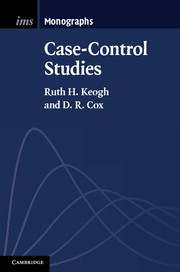Book contents
- Frontmatter
- Contents
- Preface
- Preamble
- Notes
- 1 Introduction to case-control studies
- 2 The simplest situation
- 3 Matched case-control studies
- 4 A general formulation
- 5 Case-control studies with more than two outcomes
- 6 Special sampling designs
- 7 Nested case-control studies
- 8 Case-subcohort studies
- 9 Misclassification and measurement error
- 10 Synthesis of studies
- Appendix: A theoretical diversion
- References
- Index
3 - Matched case-control studies
Published online by Cambridge University Press: 05 April 2014
- Frontmatter
- Contents
- Preface
- Preamble
- Notes
- 1 Introduction to case-control studies
- 2 The simplest situation
- 3 Matched case-control studies
- 4 A general formulation
- 5 Case-control studies with more than two outcomes
- 6 Special sampling designs
- 7 Nested case-control studies
- 8 Case-subcohort studies
- 9 Misclassification and measurement error
- 10 Synthesis of studies
- Appendix: A theoretical diversion
- References
- Index
Summary
• The individual matching of controls to cases in a case-control study may be used to control for confounding or background variables at the design stage of the study.
• Matching in a case-control study has some parallels with pair matching in experimental designs. It uses one of the most basic methods of error control, comparing like with like.
• The simplest type of matched case-control study takes a matched-pair form, in which each matched set comprises one case and one control.
• Matched case-control studies require a special form of analysis. The most common approach is to allow arbitrary variations between matched sets and to employ a conditional logistic regression analysis.
• An alternative analysis suitable in some situations uses a regression formulation based on the matching variables.
Preliminaries
An important and quite often fruitful principle in investigating the design and analysis of an observational study is to consider what would be appropriate for a comparable randomized experiment. What steps would be taken in such an experiment to achieve secure and precise conclusions? To what extent can these steps be followed in the observational context and what can be done to limit the loss of security of interpretation inherent in most observational situations?
In Chapter 2 we studied the dependence of a binary outcome, Y, on a single binary explanatory variable, the exposure, X.
- Type
- Chapter
- Information
- Case-Control Studies , pp. 62 - 82Publisher: Cambridge University PressPrint publication year: 2014
- 1
- Cited by



